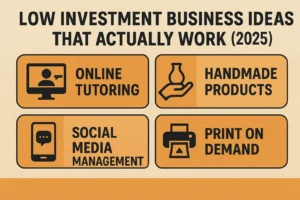Growing a small business isn’t just about working harder—it’s about working smarter. If you’re looking for effective small business growth strategies that deliver real results, you’re in the right place. Whether you’re a startup founder or an established entrepreneur, understanding how to scale your business sustainably is crucial for long-term success.
In today’s competitive marketplace, small businesses face unique challenges. Limited budgets, resource constraints, and fierce competition can make growth feel impossible. But here’s the good news: with the right strategies and focused execution, your small business can achieve remarkable growth without breaking the bank.
This comprehensive guide will walk you through proven tactics that successful entrepreneurs use to expand their operations, increase revenue, and build sustainable businesses that thrive for years to come.
Understanding the Foundation of Small Business Growth
Before diving into specific tactics, let’s clarify what business growth actually means. Growth isn’t just about revenue—it encompasses customer base expansion, market share increases, operational efficiency improvements, and brand recognition.
Successful small business owners recognize that sustainable growth requires:
- Clear vision and measurable goals
- Customer-centric approaches
- Financial discipline and planning
- Adaptability to market changes
- Strategic resource allocation
The key is finding growth strategies that align with your business model, industry, and available resources.
Leverage Digital Marketing to Expand Your Reach
Digital marketing remains one of the most cost-effective small business growth strategies available today. Unlike traditional advertising, digital channels allow you to target specific audiences, measure results precisely, and adjust campaigns in real-time.
Content Marketing That Converts
Content marketing builds trust, establishes authority, and attracts qualified leads to your business. Start by creating valuable content that addresses your customers’ pain points and questions.
Consider these content marketing approaches:
- Blog posts that answer common customer questions
- Video tutorials demonstrating your products or services
- Infographics that simplify complex information
- Case studies showcasing customer success stories
- Email newsletters with exclusive tips and offers
The secret is consistency. Publishing high-quality content regularly keeps your brand top-of-mind and improves your search engine rankings, driving organic traffic to your website.
Social Media Marketing for Business Growth
Social media platforms offer unprecedented access to your target audience. But success requires more than just posting randomly—you need a strategic approach.
Choose platforms where your customers actually spend time. A B2B software company might focus on LinkedIn, while a fashion retailer might prioritize Instagram and TikTok.
Engage authentically by responding to comments, sharing user-generated content, and participating in relevant conversations. Social media algorithms reward engagement, so building genuine connections with your audience amplifies your reach exponentially.
Search Engine Optimization (SEO) Fundamentals
SEO drives free, qualified traffic to your website long-term. While it takes time to see results, the payoff is substantial.
Focus on these SEO essentials:
- Keyword research to understand what customers search for
- On-page optimization including title tags and meta descriptions
- High-quality content that answers search intent
- Local SEO optimization for location-based businesses
- Mobile-friendly website design
- Fast page loading speeds
Remember, SEO isn’t a one-time task—it requires ongoing optimization and adaptation to algorithm changes.
Optimize Customer Retention for Sustainable Growth
Acquiring new customers costs five to seven times more than retaining existing ones. That’s why customer retention is one of the most powerful business expansion tactics you can implement.
Build a Customer Loyalty Program
Loyalty programs incentivize repeat purchases while making customers feel valued. They don’t need to be complicated—even simple point-based systems can significantly boost retention rates.
Consider offering rewards like discounts on future purchases, exclusive access to new products, birthday bonuses, or referral incentives. The key is making customers feel appreciated for their continued business.
Deliver Exceptional Customer Service
Outstanding customer service creates brand advocates who promote your business through word-of-mouth—the most trusted form of marketing.
Train your team to go beyond solving problems. Empower them to create memorable experiences that exceed customer expectations. Quick response times, personalized communication, and proactive problem-solving build the kind of loyalty money can’t buy.
Implement Customer Feedback Systems
Your customers have valuable insights about what’s working and what needs improvement. Create easy ways for them to share feedback through surveys, reviews, and direct communication channels.
More importantly, act on that feedback. When customers see you implementing their suggestions, it strengthens their connection to your brand and increases retention.
Diversify Your Revenue Streams
Relying on a single product, service, or customer segment creates vulnerability. Diversification spreads risk while opening new growth opportunities.
Expand Your Product or Service Line
Analyze your existing offerings to identify natural extensions. What complementary products or services would add value for your current customers?
For example, a bakery might add catering services, or a consulting firm might develop online courses. The key is leveraging your existing expertise and customer relationships.
Explore New Market Segments
Your current product might appeal to customer segments you haven’t targeted. Research adjacent markets where your offering solves similar problems.
Geographic expansion is another diversification strategy. Can you serve customers in new locations through e-commerce, franchising, or additional physical locations?
Create Passive Income Opportunities
Passive income streams generate revenue with minimal ongoing effort. Digital products like e-books, online courses, templates, or software tools can be created once and sold repeatedly.
Affiliate marketing, advertising revenue from content, and licensing your intellectual property are additional passive income options worth exploring.
Strategic Partnerships and Networking
No business succeeds in isolation. Strategic partnerships multiply your capabilities without proportionally increasing costs.
Form Strategic Alliances
Identify businesses that serve your target audience but aren’t direct competitors. Partner to cross-promote, bundle offerings, or collaborate on projects that benefit both parties.
For example, a wedding photographer might partner with florists, venues, and caterers to create comprehensive packages while sharing referrals.
Join Industry Associations and Networks
Professional associations provide networking opportunities, industry insights, and credibility. Active participation positions you as a thought leader while connecting you with potential partners, customers, and mentors.
Attend conferences, join online communities, and contribute to discussions. The relationships you build often lead to unexpected growth opportunities.
Leverage Influencer Partnerships
Influencer marketing isn’t just for big brands. Micro-influencers with engaged niche audiences can deliver impressive ROI for small businesses.
Look for influencers whose values align with your brand and whose followers match your target customer profile. Authentic partnerships where influencers genuinely appreciate your offering perform better than purely transactional relationships.
Invest in Technology and Automation
Technology levels the playing field, allowing small businesses to operate with enterprise-level efficiency.
Implement Customer Relationship Management (CRM) Systems
CRM software centralizes customer information, tracks interactions, and automates follow-ups. This ensures no opportunity falls through the cracks while providing insights to improve your sales process.
Popular options like HubSpot, Salesforce, and Zoho offer scalable solutions for businesses of all sizes.
Automate Repetitive Tasks
Time is your most valuable resource. Automation tools handle repetitive tasks like email marketing, social media posting, invoicing, and appointment scheduling.
This frees your team to focus on high-value activities that directly drive growth—like strategy development, customer relationship building, and innovation.
Use Data Analytics for Decision Making
Data-driven decisions outperform gut instinct. Analytics tools provide insights into customer behavior, marketing performance, sales trends, and operational efficiency.
Google Analytics, social media insights, and industry-specific analytics platforms help you understand what’s working so you can double down on successful strategies and eliminate underperformers.
Financial Management for Growth
Strong financial management is the backbone of sustainable business growth. Without proper financial controls, rapid expansion can quickly lead to cash flow problems.
Create Detailed Financial Projections
Develop realistic financial projections that account for different growth scenarios. Understanding your cash flow needs helps you avoid the growth traps that sink many small businesses.
Model best-case, expected, and worst-case scenarios. This preparation enables quick pivots when circumstances change.
Secure Appropriate Funding
Growth often requires capital investment. Explore funding options including small business loans, lines of credit, angel investors, venture capital, or crowdfunding.
Each funding source has pros and cons. Debt maintains ownership but requires repayment regardless of performance, while equity funding provides capital without debt obligations but dilutes ownership.
Monitor Key Performance Indicators (KPIs)
Track metrics that actually matter for your business. Common growth-related KPIs include customer acquisition cost, customer lifetime value, monthly recurring revenue, gross margin, and cash runway.
Regular KPI monitoring helps you spot problems early and capitalize on opportunities quickly.
Build a Strong Company Culture
As your business grows, maintaining culture becomes increasingly important. Strong culture attracts talent, boosts productivity, and improves retention.
Define Your Core Values
Articulate what your business stands for beyond making money. Clear values guide decision-making, shape customer experience, and differentiate your brand.
Live these values consistently. Employees and customers quickly spot authenticity—or the lack thereof.
Invest in Employee Development
Your team drives growth. Investing in their development through training, mentorship, and career advancement opportunities creates a motivated workforce committed to your success.
Skilled, engaged employees deliver better customer experiences, innovate more effectively, and stay with your company longer—reducing costly turnover.
Foster Innovation and Adaptability
Encourage your team to experiment, share ideas, and challenge the status quo. Some of the best growth strategies emerge from frontline employees who interact directly with customers and processes.
Create safe spaces for innovation where failure is seen as learning rather than punishment.
Conclusion
Implementing effective small business growth strategies requires commitment, patience, and strategic thinking. There’s no magic bullet—sustainable growth comes from consistently executing multiple proven tactics that work synergistically.
Start by assessing your current situation honestly. Where are your biggest opportunities? What resources do you have available? Which strategies align best with your business model and industry?
Choose 2-3 high-impact strategies from this guide and commit to executing them well for at least six months. Track results, learn from data, and adjust your approach based on what’s working.
Remember, the most successful small businesses don’t necessarily have the biggest budgets or the most innovative products. They win by consistently delivering value to customers, adapting to market changes, and executing fundamental growth strategies with discipline and focus.
Your small business has tremendous potential. With the right strategies and unwavering commitment, you can achieve the growth you envision. Start today, stay consistent, and watch your business transform into the successful enterprise you’ve always imagined. The journey from small business to thriving company isn’t easy, but it’s absolutely achievable. Which growth strategy will you implement first?
FAQs
Q What is the fastest way to grow a small business?
While there’s no universal “fastest” method, digital marketing combined with exceptional customer service typically delivers quick results. Focus on high-impact activities like SEO, social media marketing, and customer retention programs that compound over time.
Q How much should I invest in growth strategies?
A common guideline is allocating 7-10% of revenue to marketing for established businesses, while startups might invest 12-20%. However, the right amount depends on your industry, growth stage, and specific circumstances. Start with what you can afford and scale based on ROI.
Q What are the biggest mistakes small businesses make when trying to grow?
Common mistakes include growing too fast without proper infrastructure, neglecting existing customers while chasing new ones, underestimating capital requirements, failing to delegate, and pursuing growth opportunities that don’t align with core competencies.
Q How long does it take to see results from growth strategies?
Timeline varies by strategy. Paid advertising can deliver immediate results, while SEO and content marketing typically take 6-12 months. Customer retention programs show impact within 3-6 months. Sustainable growth requires patience and consistent execution.
Q Should I focus on one growth strategy or multiple?
Diversification reduces risk, but spreading too thin dilutes impact. Start with 2-3 strategies that align with your strengths and resources. Master these before expanding to additional tactics. Quality execution of fewer strategies beats mediocre execution of many.
Read More: How New Tax Hikes Crush Business Confidence in 2025








